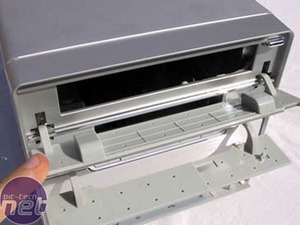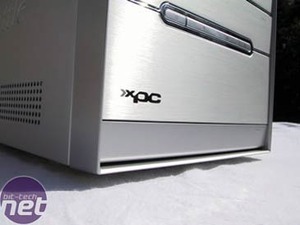Although we have mentioned that the chassis is constructed from aluminium, the front panel is not actually made from aluminium - it is in fact an aluminium-look perspex front. Fear not though, as the main body of the chassis is constructed from aluminium making it quite light in comparison to other XPC's.
Again, much like the SN25P that we looked at last month, the ST20G5 features an embossed Shuttle logo down the side of the case along with the ventilation holes that help to keep the internal components cool. We're still not too sure whether we like this embossed logo, but we guess it is here to stay for the time being. If we moan enough about it, maybe Shuttle will change their mind in the future...
Shuttle has adopted the same tool-less installation that we discovered on the SN25P XPC. The thumb screws can be turned using a screw driver too, so if you have been blessed with larger-than-normal hands you will not encounter problems installing components in to the chassis.

 The front panel of the chassis has both hidden 5.25" and 3.5" bays. The former allows just about anything but a slot loading DVD drive to be installed in to the chassis. This is, of course, providing that the eject button on your chosen drive lines up with the front panel so that it can be operated without issue. As with the SN25P, there are also additional hidden ports at the bottom of the front fascia. This is the standard selection of ports that are found on the majority of shipping Shuttle XPC's today, comprising of two USB 2.0 ports, a mini Firewire port and front audio connections.
The front panel of the chassis has both hidden 5.25" and 3.5" bays. The former allows just about anything but a slot loading DVD drive to be installed in to the chassis. This is, of course, providing that the eject button on your chosen drive lines up with the front panel so that it can be operated without issue. As with the SN25P, there are also additional hidden ports at the bottom of the front fascia. This is the standard selection of ports that are found on the majority of shipping Shuttle XPC's today, comprising of two USB 2.0 ports, a mini Firewire port and front audio connections.
The back panel has a rather unique array of connectors including both a DVI and VGA port, allowing for dual monitor support without the need for a discrete video card. In addition to this, there are two PS/2 ports, a single IEEE1394 Firewire port, a Gigabit Ethernet port and five audio jacks for the onboard 8-channel high-definition audio codec.

 The addition of both the DVI and VGA connections comes at a cost though - there are only two USB 2.0 ports on the back panel, and legacy serial and parallel ports have also been sacrificed to allow for multiple monitor support. As with the SN25P, there is the welcomed inclusion of a reset CMOS button on the back panel, meaning that users need not open the case when trying to get the most out of this barebones. Finally, there are optical S/PDIF in and out ports above the two full-size PCI card slots.
The addition of both the DVI and VGA connections comes at a cost though - there are only two USB 2.0 ports on the back panel, and legacy serial and parallel ports have also been sacrificed to allow for multiple monitor support. As with the SN25P, there is the welcomed inclusion of a reset CMOS button on the back panel, meaning that users need not open the case when trying to get the most out of this barebones. Finally, there are optical S/PDIF in and out ports above the two full-size PCI card slots.
For those of you who were looking for an all-inclusive Home Theatre solution, you may be disappointed to learn that there is no TV-Out port onboard, meaning that you will have to install a discrete PCI-Express video card if TV-Out is required.
Again, much like the SN25P that we looked at last month, the ST20G5 features an embossed Shuttle logo down the side of the case along with the ventilation holes that help to keep the internal components cool. We're still not too sure whether we like this embossed logo, but we guess it is here to stay for the time being. If we moan enough about it, maybe Shuttle will change their mind in the future...
Shuttle has adopted the same tool-less installation that we discovered on the SN25P XPC. The thumb screws can be turned using a screw driver too, so if you have been blessed with larger-than-normal hands you will not encounter problems installing components in to the chassis.


The back panel has a rather unique array of connectors including both a DVI and VGA port, allowing for dual monitor support without the need for a discrete video card. In addition to this, there are two PS/2 ports, a single IEEE1394 Firewire port, a Gigabit Ethernet port and five audio jacks for the onboard 8-channel high-definition audio codec.


For those of you who were looking for an all-inclusive Home Theatre solution, you may be disappointed to learn that there is no TV-Out port onboard, meaning that you will have to install a discrete PCI-Express video card if TV-Out is required.

MSI MPG Velox 100R Chassis Review
October 14 2021 | 15:04






Want to comment? Please log in.